A work of art you can eat
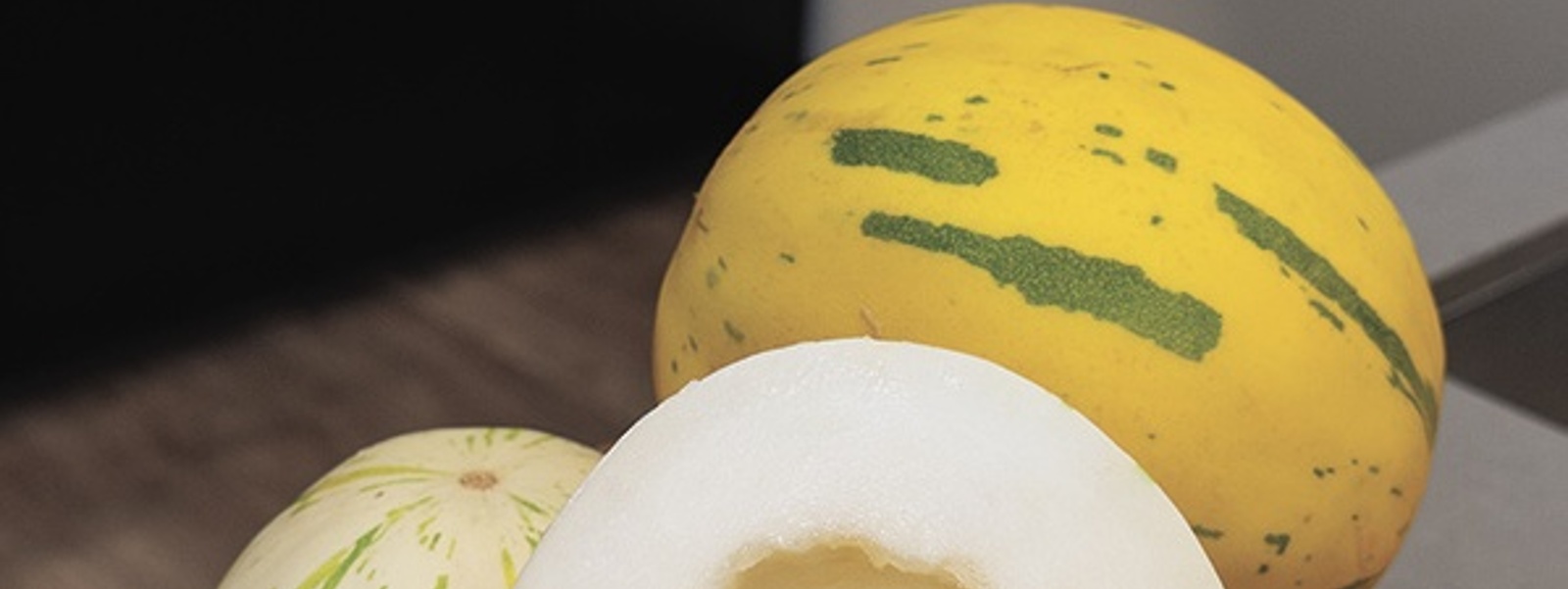
Summer 2025 California Bountiful magazine
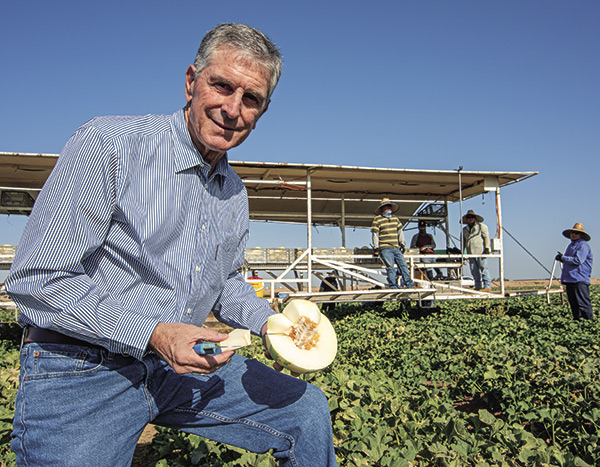
‘Painted’ Picasso melons are a summer standout
Story by Christine Souza
Farm photos by Kevin Marty
Food photos by Kassie Van Dyke
Named for artist Pablo Picasso because of its colorful splotched exterior, the trademarked melon variety known as the Picasso is part of an expanding portfolio of flavor-packed hybrids grown exclusively by Five Crowns Marketing based in Brawley.
“The plant breeders are working diligently to create what the consumer likes, which is a larger melon with a good flavor profile,” says Joe Colace, who co-founded the family-owned farming operation Five Crowns Marketing in 1983 with his brother Bill. “For the Picasso, we have tremendous optimism. It is a delicious melon, so we think we can build the customer base very quickly.”
It’s not just about looks, but the visual appeal of these melons is part of the draw. With distinctive spotted exteriors and richly colored flesh, each melon in the Picasso line seems designed to stand out.
“The first time I saw it, I thought it looked like it was painted,” says Daren Van Dyke, Five Crowns’ marketing director. “That’s how it got the name. Then we tasted it and knew we had a winning combination.”
The Picasso, introduced in 2021, is a white-fleshed variety developed for Five Crowns by a Japanese breeding company. The exceptionally sweet melon offers hints of Asian pear and Charentais melon. Its firmness also makes it more versatile in the kitchen whether it’s grilled, broiled with prosciutto or sliced fresh, Van Dyke says.
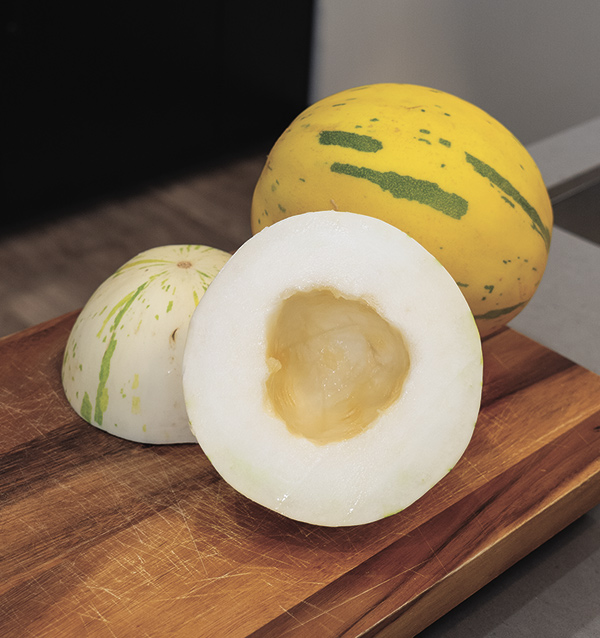
Colorful varieties
After the success of the original, Picasso Sunrise debuts this year, bringing light salmon flesh and vibrant yellow skin with splashes of green. It shares the signature crispness and sweetness of its predecessor but adds a new layer of complexity in color and flavor.
The Colace family plans to expand the lineup with two more high-sugar varieties. The Picasso Moon is a green-fleshed melon with a netted exterior, and Picasso Meloncello is a netted yellow melon with light-green flesh.
“We’re trialing new varieties with breeders constantly,” Colace says. “Our goal is to give the consumer a flavor experience they can’t find anywhere else.”
May through July is the peak summer season for spring-planted melons grown in the Imperial Valley. The fields are buzzing with activity during this time as Five Crowns harvests Picassos and other melons, including staples like watermelon, cantaloupe, honeydew and other specialty varieties. In general, plantings are staggered to provide a continuous supply of melons throughout the summer months. The desert region also harvests its fall-planted crop from October through late November. For the state’s Westside melon-growing region, harvest is from June to October. Melons are harvested and transported to the packinghouse, where they are sorted and boxed before shipping.
“We are in the midst of harvesting right now,” says Colace, noting that acreage for the Picasso varieties has expanded due to rising demand. “We’re optimistic. The customer response has been phenomenal.”
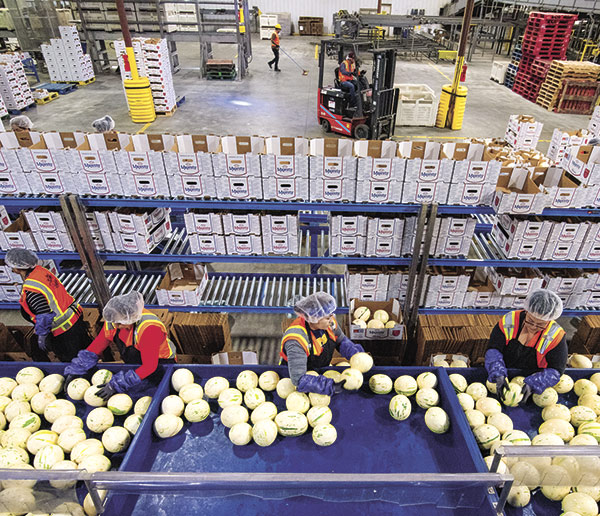
Shipped globally
Five Crowns ships its Picasso melons to major supermarket chains across the U.S. and to a few high-end restaurants and export customers in Canada, Taiwan and Korea.
Kevin Yau, a buyer for Fresh Direct Produce in Vancouver, Canada, recalls his first encounter with the Picasso melon. “They said, ‘We have this new melon—want to try it?’” Yau says. “We brought in a few pallets, and it was an instant hit with customers.” He adds that the melon is sweeter than a honeydew, holds up well in transit and has a good shelf life.
The white-fleshed Picasso, Van Dyke says, adds visual appeal to, for example, red, white and blue fruit trays alongside strawberries and blueberries for the Fourth of July, but adds the melon’s firm texture allows for culinary creativity beyond just slicing and serving.
Van Dyke, who grew up on his family’s melon farm in Blythe, has a culinary arts background, has authored a cookbook and enjoys spending time as a guest chef at events, knows how to put the melons to flavorful use. From grilled melon and goat cheese bruschetta to chilled fruit salads with vanilla bean whipped cream, the Picasso proves its artistic worth in the kitchen as well.
“I love the way it holds its shape and texture,” Van Dyke says. “You can grill it, roast it, chill it—it’s incredibly versatile and packed with sugar. One retailer said it has a hint of cotton candy.”
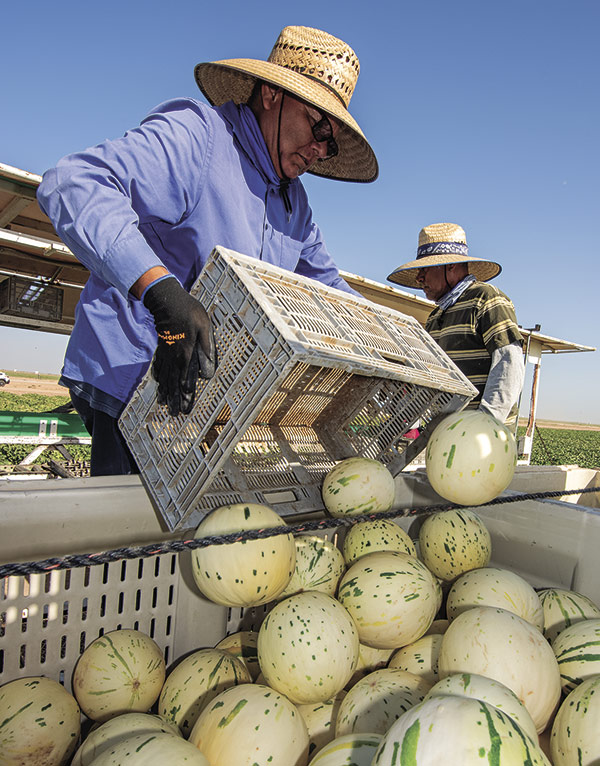
It takes teamwork
Bringing a new melon variety to market is no small feat. It takes years of collaboration between seed breeders around the world and growers like Five Crowns. Trials begin with just a few rows of plants and can grow into full-scale production if the fruit meets the criteria of taste, shelf life and shipping durability.
For the Colace family, it’s all part of a legacy built on decades of farming in California. From iceberg lettuce and asparagus to sweet corn and melons, the family’s roots run deep.
“Our philosophy is to innovate while honoring tradition,” Colace says. “Picasso melons are our way of showing that farming can be both an art and a science.”
California is golden for diverse melon varieties

Due to its hot, dry climate, California is home to many melon varieties, including primary staple varieties of cantaloupe and honeydew. But growers these days are working with fruit breeders worldwide to develop new specialty varieties, like the Picasso, to attract a fan following.
“In California, we produce all these wonderful seasonal varieties with so many different flavors and shapes and colors this time of year,” says Daren Van Dyke of Five Crowns Marketing, adding there are countless ways to prepare melons, either sweet or savory or hot or cold.
Try these chef-inspired ideas from Van Dyke:
Grilled: After grilling the Picasso melon, dice and pair with caramelized onions and goat cheese and serve on toasted crostini. Top with pine nuts and a drizzle of extra virgin olive oil.
Baked: Add Boursin cheese to a melon slice, wrap with Parma ham and bake until crispy. Serve with a raspberry vinaigrette glaze and top it with mint.
Fresh: Slice the melon into cubes and add strawberries, blueberries or other fruits and chill in the refrigerator. Serve with a vanilla bean whipped cream.
Frozen: Puree melon cubes and freeze them in an ice cube tray for a refreshing summer treat.
Van Dyke offers these tips for choosing and storing any kind of melon:
- Choose melons that are bright in color with a firm, uniform shape that are not overly hard or overly soft. Ripe melons will be slightly soft with mild thumb pressure on the stem end. Do not buy melons that are sunken, mushy or have dark spots.
- Store whole ripe or cut melons between 40 degrees and 45 degrees.
- Once cut, melons can be refrigerated for three to five days in an airtight container. Do not freeze them.

